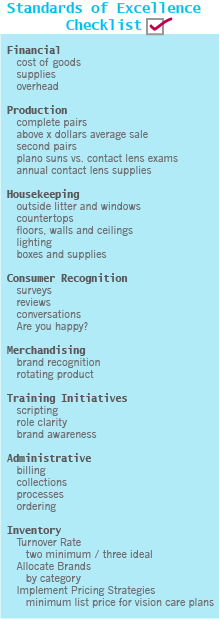The critical piece to your success operating multiple locations is the ability to implement and track results. This doesn't happen on its own. You need someone accountable to "trust but verify" what is really occurring at each location. You need to "Train the Trainer." In other words you need someone who will visit and track what is occurring at each location. In some instances, for smaller optical groups (with about two to four locations), this may be your lead manager who visits each of the other locations one day per week but who is not on the schedule to work with patients.
Over all, one "lead" manager in theory can handle up to three other locations, including their own. This way they can visit each location at least once per month. If you have 12 locations, three managers at a time would be acting as leads. Many chains rotate these leads each quarter. This person should have time allocated with the manager and the staff of the location they are visiting to train them and to review results. This is done to assess the strengths and weaknesses of those supporting your strategies and to, in real time, modify and or refine what is being done while reporting back to the owner.

It's not enough to have "managers" at each location. Each manager has to wear another hat—the trainer. Every manager in each location must be able to teach their team as if they were trainers too. This is the "Pay It Forward" philosophy. The "trainer" trains the manager to be a trainer too. In this way, you create an army of trainers that can support the culture and strategies for success.
When one of the major corporate optical retailers rolls out a new strategy, they start with a full "train the trainer" retreat day to launch it the right way. It is well thought out and organized. It provides for some flexibility, but overall, everyone understands that you are either on the train (pardon the pun) or you get left behind. They bring in outside talent to train and practice the strategy they want to implement. Then they get everyone excited about the impact this will have and create some healthy competition in the form of contests related to the date the roll out is accomplished followed by the percentages by which the numbers are to have increased.
They take it even further by assessing how their folks are talking to patients and what they are saying along with how their offices look and are merchandised. Every aspect of the consumer experience is taken into consideration. Very clear and obtainable goals along with consistency in delivering the strategies are monitored.
We know that there is a domino effect when you train the trainer. Getting everyone involved is the key to success. After you teach your manager to become the trainer, you need to role play with them as if you were the patient. Get involved in the training, including both learning how to train as well as practicing becoming the patient. Make sure that every member of the staff, regardless of job title or responsibilities, is involved and is learning what needs to be said or done. Let them also take turns acting as patients during role playing exercises.
Once this training culture is in place, hiring and expanding your staff becomes easier. Service to your patients becomes more consistent. This all leads to increasing revenues, higher consumer appreciation and improved employee job satisfaction.
Getting started is typically the hardest step when training a trainer. The first step is to start creating materials you'll need for consistency. From the time the patient enters the parking lot, to the time they walk back to their car, there should be a checklist of steps each staff takes to ensure the highest level of service. This includes examining the environment around the office for the patient's senses—sight, sound, smell and touch.
Let the "Standards of Excellence" checklist be your guide to success. Your managers can start compiling yours today. Refine it together and let them visit one practice per week and collect information for each category on the list. This exercise, performed regularly, will yield more consistency between offices, an improved patient experience and overall more profitability.
Jay Binkowitz, optometric business consultant, is chief executive officer and president of GPN, exclusive provider of The EDGE.
Evan Kestenbaum, MBA, is chief information officer of GPN, Exclusive Provider of The EDGE. Contact Jay and Evan directly at clientservices.gpn@gmail.com.